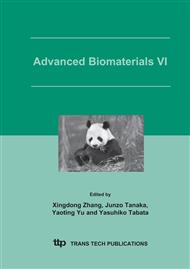p.625
p.629
p.633
p.637
p.641
p.645
p.649
p.653
p.657
Improving Wear Resistance by Heat-Treatment in Different Atmospheres
Abstract:
Influence of heat-treatment conditions on wear resistance of titanium was investigated. Titanium plates were subjected to heat-treatment in air and water vapor respectively. Heat-treatments increased micro-hardness of titanium. The plate heat-treated in air (H) has the highest roughness and the plate treated in water vapor (W) lowest. After heat-treatment surface oxide was rutile. The friction coefficient of W was the lowest and almost stable at about 0.18. Non-heat--treated titanium plate (S) had a highest coefficient up to 1.1. Wear resistance of heat--treated titanium, especially W was significantly superior to non-treated titanium. The wear of S resulted mainly from adhesion failure, H involved with abrasive wear and fatigue failure. For W, a complex wear mechanism was probably existed.
Info:
Periodical:
Pages:
641-644
Citation:
Online since:
June 2005
Authors:
Price:
Сopyright:
© 2005 Trans Tech Publications Ltd. All Rights Reserved
Share:
Citation:


